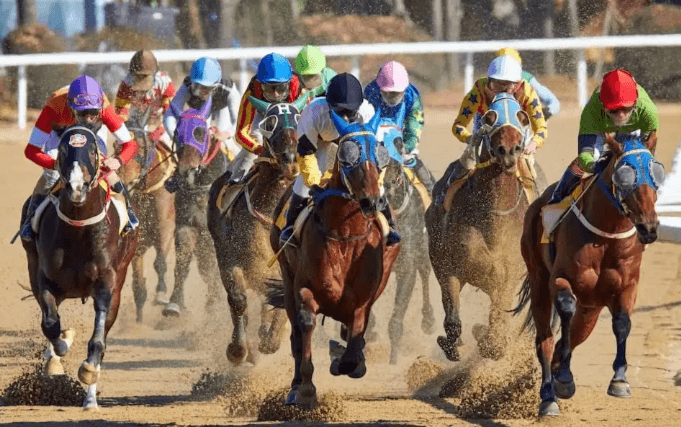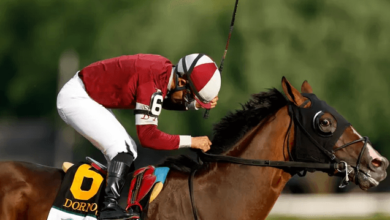How do you determine the appropriate race distance for a horse?

Introduction
Determining the appropriate race distance for a horse is a complex task that requires a deep understanding of the horse’s unique characteristics, physical capabilities, and training regimen. Horse racing is not just about speed; it’s also about stamina, strategy, and understanding the intricate balance between these elements. Whether you’re a seasoned trainer or a new owner, finding the optimal distance can significantly impact your horse’s performance and long-term health.
Understanding Horse Racing Distances
Horse racing distances vary widely, typically ranging from sprints of around five furlongs (approximately 1,000 meters) to endurance races that can extend beyond two miles (about 3,200 meters). Each distance demands different physical and mental attributes from the horse. Understanding these distances is the first step in determining which one suits your horse best.
Shorter races require bursts of speed and explosive energy, while longer races demand endurance, pacing, and the ability to maintain a steady rhythm over a more extended period. The wrong distance can exhaust a horse, increasing the risk of injury and reducing its competitive lifespan.
Evaluating the Horse’s Genetics
A horse’s genetics play a significant role in determining its ideal race distance. Thoroughbreds, the most common breed in horse racing, have bloodlines that can hint at their racing potential. Some lines are known for producing sprinters, while others are famous for endurance.
When evaluating a horse’s genetics, look at the performance history of its sire (father) and dam (mother), as well as other relatives. If a horse comes from a lineage of successful sprinters, it’s more likely that short-distance races will be its forte. Conversely, if its ancestors excelled in longer races, the horse might be better suited for distance racing.
Assessing the Horse’s Physical Attributes
Physical attributes are also critical in determining the appropriate race distance. Key factors to consider include:
- Muscle Composition: Horses with a higher proportion of fast-twitch muscle fibers excel in short sprints, while those with more slow-twitch fibers perform better over longer distances.
- Body Size and Conformation: A horse’s body structure can influence its racing style. Lighter, leaner horses often perform better in distance races, while more muscular, compact horses are generally sprinters.
- Leg Length and Stride: Horses with longer legs and strides can cover more ground efficiently, making them more suitable for longer races.
Regular veterinary assessments and biomechanical evaluations can provide insights into your horse’s physical makeup, helping you tailor its racing strategy accordingly.
The Importance of Training and Conditioning
Training and conditioning are crucial in preparing a horse for its optimal race distance. Even a genetically gifted horse will struggle if it’s not properly trained for the specific demands of a race.
- Endurance Training: For longer races, focus on building stamina through long, steady workouts that increase aerobic capacity. This includes distance gallops and hill work to strengthen the horse’s cardiovascular system and muscles.
- Speed Work: For sprinters, emphasize short, high-intensity workouts that develop the horse’s ability to accelerate quickly and maintain top speed over a short distance. Interval training, with alternating bursts of speed and rest, is effective for this purpose.
- Balanced Regimen: Regardless of the distance, a balanced training regimen that includes both speed and endurance work is essential. This ensures that the horse can handle various race scenarios, including fast starts and strong finishes.
Analyzing Past Performances
A horse’s racing history offers valuable insights into its optimal distance. Analyze its past performances to identify patterns in its success and failure at different distances. Pay attention to the following:
- Race Times: Compare how the horse’s times vary across different distances. A horse that consistently performs better in shorter races may not have the stamina for longer distances, and vice versa.
- Finishing Positions: Observe where the horse tends to finish in races of varying lengths. A strong finish in longer races could indicate good endurance, while fading late in shorter races might suggest a need for more stamina training.
- Competitive Level: Consider the class of competition in which the horse has raced. A horse that excels at a certain distance against lower-level competition may struggle when stepping up in class at the same distance.
The Role of Jockeys and Riding Style
The jockey’s riding style can significantly influence a horse’s performance over different distances. Some jockeys excel at managing a horse’s energy in longer races, pacing them for a strong finish. Others are more adept at urging a horse to sprint from the start and maintain its speed in shorter races.
When determining the appropriate race distance, consider how well your horse responds to different jockeys and their riding styles. A good match between horse and jockey can enhance performance, especially if the jockey understands the horse’s strengths and weaknesses at various distances.
Environmental and Track Conditions
Race distance selection isn’t just about the horse’s physical attributes; external factors like environmental and track conditions also play a role. Different surfaces (dirt, turf, synthetic) can affect a horse’s performance at varying distances.
- Track Surface: Horses may perform differently on dirt versus turf or synthetic tracks. Some horses have a preference for a particular surface, which can affect their stamina and speed.
- Weather Conditions: Weather can also influence race strategy. For example, a horse that struggles in hot weather may not be suited for longer races held in the summer months.
- Track Configuration: Some tracks have tighter turns or longer straights, which can benefit certain running styles. Understanding how your horse handles different track layouts can help in choosing the appropriate race distance.
Psychological Factors
A horse’s mental state and temperament are often overlooked but are crucial in determining race distance. Some horses have the mental fortitude for longer races, maintaining focus and drive over extended periods, while others might excel in the quick, high-energy atmosphere of shorter sprints.
Training a horse for the mental demands of racing is as important as physical conditioning. Horses that are easily distracted or become anxious may struggle in longer races where focus is paramount. Conversely, a horse that remains calm and focused can conserve energy and perform better in endurance races.
Testing and Trial Runs
Before committing to a specific race distance, it’s wise to test your horse at various distances in trial runs or less competitive races. This allows you to observe how the horse handles different demands and adjust its training regimen accordingly.
Trial runs help you understand how a horse responds to different distances under race-like conditions without the pressure of a major competition. Use these opportunities to experiment with different race strategies, pacing, and jockey instructions.
The Importance of Pacing and Strategy
Race pacing is critical, especially in longer races. Understanding how to distribute a horse’s energy throughout the race can make the difference between winning and losing. Horses that start too fast might burn out before the finish line, while those that start too slow might not have enough speed left to catch up.
Work with the jockey to develop a pacing strategy that matches the horse’s strengths. For longer races, this might involve conserving energy in the early stages and finishing strong. In shorter races, the strategy might focus on quick acceleration and maintaining speed.
Balancing Racing Schedule and Recovery
The frequency of racing also influences the optimal distance for a horse. Horses need adequate recovery time between races, especially after longer distances that put more strain on their bodies. Overracing a horse, particularly at longer distances, can lead to fatigue, injuries, and diminished performance.
A well-planned racing schedule balances the number of races, the distances, and the recovery periods. This ensures that the horse remains in peak condition without risking its health.
Adjusting Over Time: Age and Development
A horse’s optimal race distance can change over time due to age, physical development, and accumulated racing experience. Young horses may start their careers as sprinters due to their limited stamina but could develop into distance runners as they mature.
Monitor your horse’s development and adjust its racing distances as needed. Older horses might need to shift to shorter distances if their endurance wanes, while younger horses might gradually be tested at longer distances as their stamina improves.
External Expert Consultation
Consulting with veterinarians, trainers, and equine specialists can provide additional insights into determining the appropriate race distance. These experts can offer advice based on the latest research, diagnostic tools, and their experience with similar horses.
Regular veterinary check-ups, biomechanical assessments, and blood tests can reveal underlying conditions or physical traits that might not be immediately apparent but could influence the horse’s racing potential.
Nutritional Considerations
A horse’s diet plays a crucial role in its ability to perform at different race distances. Endurance races require a diet that supports sustained energy release, while sprinting horses might need more focus on quick energy sources.
Work with a nutritionist to develop a diet tailored to your horse’s race distance. This includes the right balance of carbohydrates, proteins, fats, vitamins, and minerals to optimize energy, muscle recovery, and overall health.
The Influence of Technology and Data Analysis
Modern technology offers powerful tools for determining the appropriate race distance for a horse. Wearable devices can track a horse’s heart rate, stride length, and other vital metrics during training. Analyzing this data helps in understanding how a horse’s body responds to different distances and training intensities.
Data analysis software can also help in comparing a horse’s performance across various races, identifying trends, and predicting future performance at specific distances. Leveraging technology can provide a competitive edge in making informed decisions about race distances.
The Impact of Competition Level
The level of competition also affects race distance selection. A horse that performs well at a specific distance in lower-class races may struggle when facing stronger competitors. It’s important to match the horse’s abilities not only to the distance but also to the quality of the competition.
If your horse is stepping up in class, it might be necessary to adjust the race distance until it’s proven itself at the new level. Sometimes, success at a lower level can be misleading if the competition wasn’t as strong.
Recognizing Signs of Overexertion
Understanding when a horse is overexerted is crucial for its health and performance. Signs of overexertion include excessive sweating, labored breathing, and a drop in performance. These signs are more likely to appear if a horse is raced at an inappropriate distance.
Regular monitoring and knowing your horse’s limits can prevent overexertion. If a horse consistently shows signs of fatigue after races at a certain distance, it may be time to reconsider the length of its races.
FAQs
How does a horse’s age affect its ideal race distance?
As horses age, their stamina and speed can change. Younger horses may be better suited for shorter races due to their developing endurance, while mature horses might excel at longer distances.
Can a horse be trained to run longer distances over time?
Yes, with proper training and conditioning, a horse can be gradually trained to handle longer distances. However, this should be done carefully to avoid injury.
How do I know if my horse is a sprinter or an endurance runner?
Observing your horse’s performance in trial runs and analyzing its physical attributes, such as muscle composition and stride length, can help determine whether it’s better suited for sprinting or endurance races.
What role does diet play in determining a horse’s race distance?
Diet is crucial in providing the necessary energy for different race distances. Endurance horses need a diet that supports sustained energy, while sprinters require quick energy sources.
How often should a horse race to stay in peak condition?
The racing schedule should balance races and recovery time, with longer races typically requiring more recovery time. Overracing can lead to fatigue and injuries.
Can environmental conditions affect my horse’s performance at different distances?
Yes, factors such as track surface, weather, and track configuration can influence a horse’s performance and may necessitate adjustments in race distance.
Conclusion
Determining the appropriate race distance for a horse is a multifaceted process that involves understanding the horse’s genetics, physical attributes, training regimen, and psychological makeup. It also requires careful consideration of external factors such as track conditions, competition level, and the horse’s overall health. By taking a comprehensive approach and regularly reassessing these factors, you can optimize your horse’s performance and enhance its racing career.




